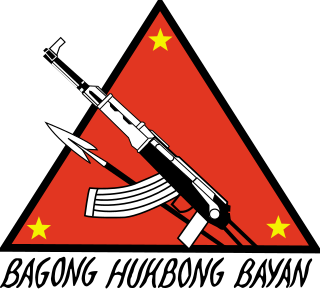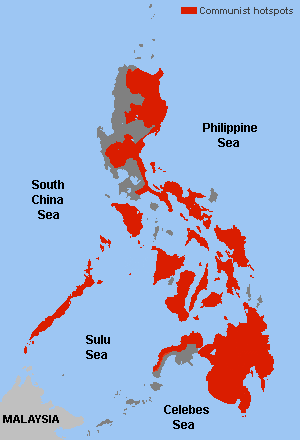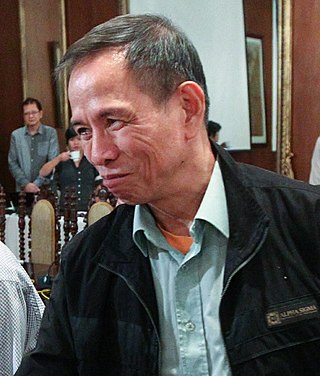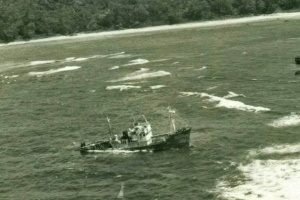
The New People's Army, abbreviated NPA or BHB, is the armed wing of the Communist Party of the Philippines (CPP). It acts as the CPP's principal organization, aiming to consolidate political power from what it sees as the present "bourgeois reactionary puppet government" and to aid in the "people's democratic revolution". Founded on March 29, 1969, by the collaboration of Jose Maria Sison and former members of the Hukbalahap led by Bernabe Buscayno, the NPA has since waged a guerrilla war based on the Maoist strategy of protracted people's war. The NPA is one of the key figures in the ongoing Communist rebellion in the Philippines, the longest ongoing conflict in the country.

The Communist Party of the Philippines is a far-left, Marxist–Leninist–Maoist revolutionary organization and communist party in the Philippines, formed by Jose Maria Sison on 26 December 1968. It is designated as a terrorist group by the United States Department of State together with Sison and its armed wing New People's Army (NPA) in 2002. The European Union renewed its terrorist designation on the organization in 2019, though a 2009 ruling by the EU's second highest court delisted Sison as a "person supporting terrorism" and reversed a decision by member governments to freeze assets. According to the US' Central Intelligence Agency (CIA) World Factbook, the CPP and the NPA aims to destabilize the Philippines' economy and overthrow the national government.

Jose Maria Canlas Sison, also known by his nickname Joma, was a Filipino writer, poet and activist who founded the Communist Party of the Philippines (CPP) and added elements of Maoism to its philosophy – which would be known as national democracy. He applied the theory of Marxism–Leninism–Maoism to the history and current circumstances of the Philippines.

Filemon Castelar Lagman, popularly known as Ka Popoy, was a revolutionary socialist and workers' leader in the Philippines. He shares the ideology of Marxism-Leninism. He split with the Communist Party of the Philippines in 1991 to form Bukluran ng Manggagawang Pilipino (BMP) and the multi-sectoral group Sanlakas.

The Revolutionary Workers' Party of the Philippines is a communist party that split from the Communist Party of the Philippines during the Second Great Rectification Movement.

The New People's Army rebellion is an ongoing conflict between the government of the Philippines and the New People's Army (NPA), which is the armed wing of the Marxist–Leninist–Maoist Communist Party of the Philippines (CPP). It is the world's longest ongoing communist insurgency, and is the largest, most prominent communist armed conflict in the Philippines, seeing more than 43,000 insurgency-related fatalities between 1969 and 2008. Because the National Democratic Front of the Philippines (NDFP) which is the legal wing of the CPP, is often associated with the conflict, it is often also called the CPP-NPA-NDF conflict, or simply the C/N/N conflict, especially in the context of peace talks with the Philippine government.

The history of communist armed conflicts in the Philippines is closely related to the history of Communism in the Philippines, with various armed conflict linked to the armed wings of the various communist organizations that have evolved since 1930. The two largest conflicts have been the Hukbalahap Rebellion of 1942–1954, and the ongoing rebellion of the New People's Army, which began in 1969 under the auspices of the Communist Party of the Philippines (CPP). But various splinter groups have since separated from the CPP and have had a history of armed conflict with the Philippine government since then.
Communism in the Philippines emerged in the first half of the 20th century during the American Colonial Era of the Philippines. Communist movements originated in labor unions and peasant groups. The communist movement has had multiple periods of popularity and relevance to the national affairs of the country, most notably during the Second World War and the Martial Law Era of the Philippines. Currently the communist movement is underground and considered an insurgent movement by the Armed Forces of the Philippines.
The following is the timeline of events of CPP-NPA-NDF rebellion, a conflict between the government of the Philippines, the Communist Party of the Philippines (CPP), the New People's Army (NPA) and the National Democratic Front (NDF).

The Alex Boncayao Brigade was the urban assassination unit of the New People's Army, the armed wing of the Communist Party of the Philippines. Organized in 1984, the unit broke away from the New People's Army as a consequence of a split in ideology during the 1990s. In 1997, the Alex Boncayao Brigade allied itself with the Revolutionary Proletarian Army, the armed wing of the Revolutionary Workers' Party.
The Revolutionary Proletarian Army, also known by the acronym RPA, was the military wing of the Revolutionary Workers' Party (RPM-P), a communist party that split from the Communist Party of the Philippines.
The First Great Rectification Movement refers to a 1965 ideological movement by Filipino communists led by Jose Maria Sison wherein they "criticized, repudiated and rectified the major ideological, political and organizational errors and weaknesses" of the 1930s-era Communist Party of the Philippines. This rectification movement led to the reestablishment of the Communist Party of the Philippines on December 26, 1968 along Marxist–Leninist–Maoist Thought.

Benito Tiamzon was a Filipino political organizer and until his arrest in March 2014 by Philippine security forces, was believed to be the Chairman of the Communist Party of the Philippines (CPP) and its armed wing, the New People's Army (NPA).

Wilma Tiamzon was a Filipino political organizer and until her arrest in March 2014 by Philippine security forces, believed to be the Secretary-General of the Communist Party of the Philippines (CPP) and its armed wing, the New People's Army (NPA).

Kabataang Makabayan, also known by the acronym KM, is an underground communist youth organization in the Philippines which was active from 1964 to 1975. It was banned by the Philippine government in 1972 when then-President Ferdinand Marcos declared martial law, and was driven underground. It was dissolved in 1975 along with other National Democratic mass organizations, as part of the National Democratic movement's change of strategy against the Marcos regime. Revived within the Manila-Rizal area in 1977 and later nationally in 1984, the organization continues to exist.
Gregorio Rosal also known by his nom-de-guerre Ka Roger, was the leader of the Melito Glor Command of the New People's Army (NPA) in the Southern Tagalog region of the Philippines, and spokesperson of the Communist Party of the Philippines (CPP) from 1994 until 2006.
Fidel V. Agcaoili, also known as Ka Fidel, was a Filipino activist and revolutionary. He was a member of the Communist Party of the Philippines' Central Committee, along with Jose Maria Sison and Luis Jalandoni during the Marcos dictatorship. In 1974, he was arrested and became the longest detained political prisoner under Marcos, being imprisoned for 11 years. On his release, Agcaoili founded the Samahan ng mga Ex-Detainee Laban sa Detensyon at Aresto (SELDA), a prisoners' rights organization.
Philippine Society and Revolution, first published in 1971, is a book written by Filipino Maoist revolutionary and founder of the Communist Party of the Philippines Jose Maria Sison, under his nom de guerre Amado Guerrero. Regarded as one of the CPP's principal references, PSR has also influenced the Filipino mass movement since its first publication. It applied Maoist analysis to contemporary Filipino society, describing its class structure, its basic problems, and the "class logic of the revolutionary solution — which is the people's democratic revolution."

The July 1972 MV Karagatan incident was an unsuccessful attempt by the New People's Army — the armed wing of the Marxist–Leninist–Maoist Communist Party of the Philippines (CPP) — to smuggle armaments from China into the Philippines via the ship MV Karagatan. The incident is notable for having been cited by President Ferdinand Marcos as one of his rationales for imposing martial law in the Philippines in September 1972.













